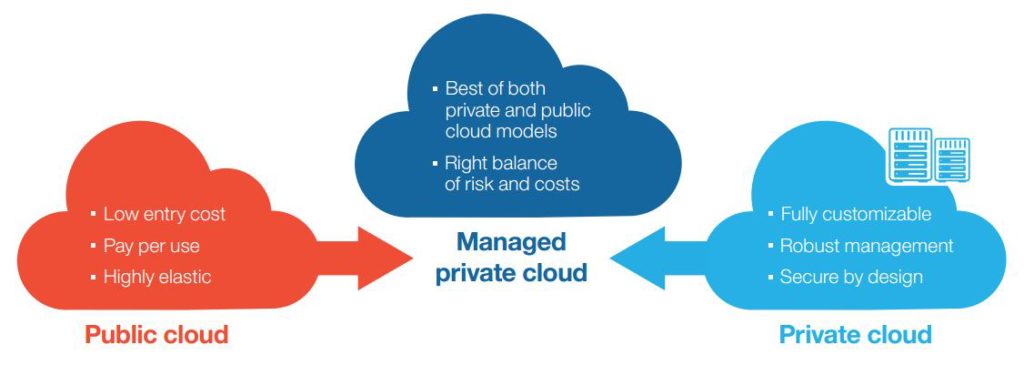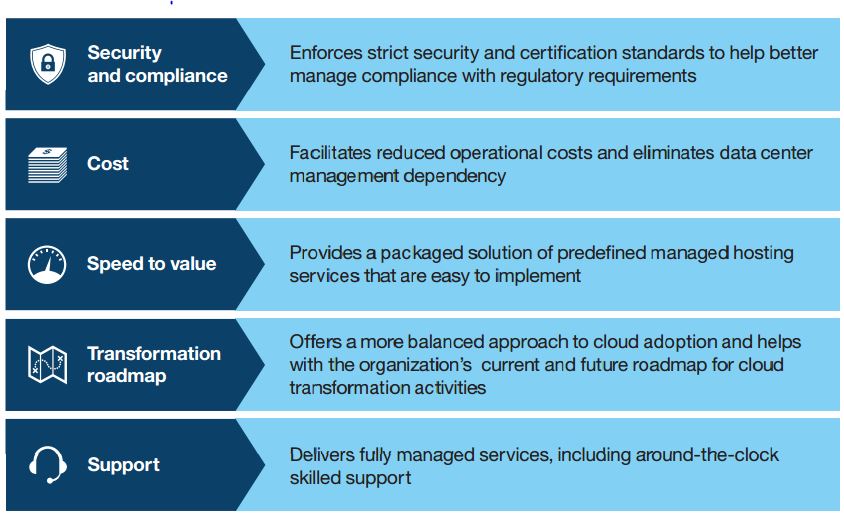Midsized organizations in particular find that moving to the cloud can provide the agility, innovation and flexibility needed to lead in their industries. And many are ready to make cloud a reality— if, and only if, they have a secure, reliable and cost-effective way to bring cloud into their organizations. Compelling as the benefits may be, it can be challenging to find the right path to cloud when you need both the security of a private cloud and the fast time to value of a public cloud.
Which cloud option fits best?
Option 1: Private cloud, offering a higher level of security and enabling better compliance with regulations and standards. But it requires additional capital expenses (CAPEX) as well as investment in hardware assets and tools.
Option 2: Public cloud, which requires no CAPEX and offers faster time to value; but this option falls short when it comes to security, reliability and regulatory compliance. In IDC’s 2014 CloudView Survey, 52 percent of respondents identified security as an inhibitor to public cloud adoption, while 34 percent expressed reliability and service availability concerns.
Option 3: Virtual automation or managed private cloud services, serves as cost-efficient alternative that better align with cloud and business requirements. This option bridges private and public cloud models— giving organizations the flexibility to adopt cloud more quickly and efficiently, without the hassle and risk of managing a private cloud and with all the ease of subscribing to a public cloud service.
With managed private clouds, businesses can address the organizational issues, complexity and high costs associated with private clouds. They can also prepare for the future viability of private cloud solutions. According to Gartner’s Planning Guide for Cloud Computing, “the emergence of virtual automation, hosted private clouds and private PaaS frameworks will put into question the viability of internal, private cloud IaaS solutions.”
This deployment model also enables organizations that are still uncertain about cloud, likely due to workload dependencies, current business strategies and costs, to test the waters without any significant commitment. In addition, a managed private cloud not only allows them to preserve their existing IT environment, but it can also support any future hybrid cloud agenda they may have.
Conclusion:
There is an alternative to public and private clouds: managed private cloud services. Prepackaged, managed hosting services can provide the best of both worlds—bridging the gaps existing cloud deployment models leave, to hit the right balance of risk and investment. With managed private cloud services, small to mid-sized businesses can adopt cloud with speed and agility.
Schedule a consultation today to learn how Flagship can help you design and implement a managed private cloud solution that is simple and efficient for your specific needs.
If you liked this blog, you also might like: Expand the Possibilities with Hybrid Cloud
IBM Cloud Services
Hybrid. Open. Secure. Cloud computing is at the center of dramatic innovation with mobile, data analysis and security as the enabler. Discover the continuum of choices for infrastructure, platform, and services to accelerate digital business.
-
How to Jump Start Your Hybrid Cloud
-
When your IT infrastructure is overloaded, you look at hybrid cloud as a solution. Watch this video to jump start your hybrid cloud or learn more here: …
-
eBook – Forbes Insight – How the cloud is changing business resilience
-
Resiliency can be a competitive advantage, not merely a technical solution with a cost. The cloud enables a broader set of companies to consider a broader set of applications to grow their businesses in the expanding data universe.
-
Infographic: 5 Common Cloud Deployment Mistakes
-
Cloud migrationis fast becoming a top priority for small businesses and enterprisesalike, as a strategy to improve efficiency, increase agility and unlock new opportunities. Many think that once they get past the internal debates, politics, and budget calculating, the hard part is behind them. Unfortunately, this is not necessarily true. Most companies make some basic mistakes and assumptions that cause their migration to the cloud to be significantly more difficult. On average, most migrations to the cloud don’t go well.
-
White Paper: When it Comes to Cloud, Knowledge is Everything
-
A comprehensive understanding of your physical and virtual infrastructures is a critical requirement before embarking on a cloud model. Know what you have and where it is.
Your cloud service model should result in IT cost savings; and it should reduce the burden and personnel resources required from your IT organization. A utility pricing model allows you to pay for what you use and eliminates the capital expense of deploying in-house hardware and software.
The major concern to be addressed is the security risk associated with cloud models.
This paper will provide an overview of cloud computing, the primary service models, available deployment models, and critical success factors for cloud computing.
-
IBM Cloud: POV on Hybrid Cloud Computing
-
An overview of IBM Cloud’s point of view on hybrid cloud computing and the hyper-portability that hybrid cloud solutions provide.
-
Infographic: IBM Leads Industry Toward Hybrid Clouds
-
Solution Brief: IBM Cloud Maturity Curve
-
Companies that have a mature organisational approach to cloud computing are more focused on business growth than cost reduction—and are more likely to have achieved that growth as well. They use a more diverse range of cloud services and are seeing improvements in the relationship between IT and the rest of the business. But while they say they have the required data-governance measures in place, privacy, security and compliance will continue to challenge even high-maturity organisations in the near future.
These are the findings from Mapping the cloud maturity curve, an IBM research project conducted by The Economist Intelligence Unit. The project defines “maturity” as it relates to the use of cloud computing (henceforth referred to as “cloud”) and measures how mature organisations are today.
A previous report, entitled The fundamental five, drew on interviews with IT leaders to identify the core components of cloud maturity. Organisations’ progress along this maturity curve was then investigated through a global survey of 784 IT and business executives (see “About the study” for a detailed description of how maturity was scored). This report is an in-depth analysis of the findings of the survey and incorporates further insights from senior IT leaders to identify how they are moving their organisations up the cloud maturity curve.
-
Hybrid cloud helps IBM clients meet business needs
-
This video describes how IBM’s hybrid cloud solutions can help with three major areas:- Portability of applications to move applications closer to the data or data closer to the applications- Visibility and control to provide robust governance and coordination to prevent, pinpoint and resolve problems across a hybrid environment. – Developer productivity by securely connecting apps, data and services and providing the ability to experiment and rapidly iterate cloud app development for hybrid environments.
-
Building a cloud road map
-
Find out how to strategically move your business towards a more nimble hybrid cloud solution. Cloud expert Tim Vanderham walks through the process of integrating cloud into your existing IT architecture. To learn more, take a look at The Steps to Cloud Expertise Series: http://www.ibm.com/cloud/expertise



